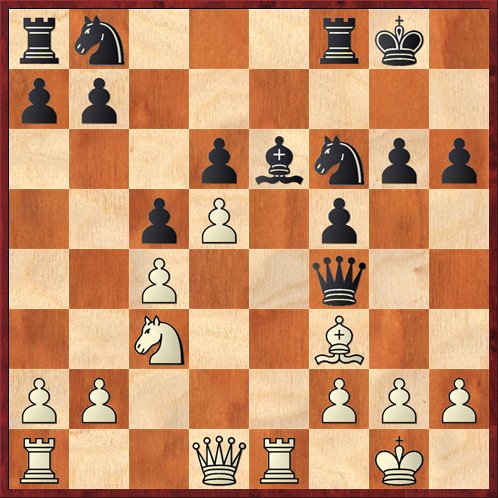Yesterday I learned a new chess principle, which very likely did not exist until yesterday. It’s called the Mike Splane Principle of Activating the Most Pieces.
The occasion was another of Mike’s chess parties. I presented one of my games from the recent U.S. Amateur Team West tournament, my victory against Tanuj Vasudeva in round five. It’s sort of a massacre and there isn’t that much to say about it, but I did make one instructive mistake.
Here’s the position after Black’s 17th move, 17. … Bxe6. How should White recapture?
White to move.
The choice of the audience at yesterday’s gathering was immediate and loud. “Pawn takes e6!” they clamored. However, in the game I played Rook takes e6. I thought it was a pretty reasonable move, so I was surprised when I found out that Rybka strongly prefers the other move. After 18. de, it rates the position as +3.0 pawns for White, and after 18. Rxe6 it is only +0.7 pawns.
I’ll say more below about the reasons for Rybka’s evaluation, but I was curious why my fellow masters and experts were so certain that 18. de was the better choice. During the game I was concerned that after 18. … Nc6 my pawn on e6 would eventually turn into a weakness rather than a strength.
Mike phrased his reasoning very succinctly. “18. de activates all of your pieces,” he said. “It gives you a new queen, a new bishop, and a new knight.” By comparison, 18. Rxe6 activates only one piece, the rook. By the Mike Splane Principle of Activating the Most Pieces, 18. de has to be better.
I’m not sure how universally valid this principle is, but what I liked about his answer is that it gives you a whole new way of looking at the position. Instead of worrying about how weak the pawn might be on e6, think instead of how badly placed it currently is on d5. On d5 it gets in the way of everything — the knight, the bishop, the queen. White would in fact be glad to sacrifice that pawn just to open the lines for his pieces. The fact that he doesn’t even have to sacrifice it, but instead can make it into a potentially dangerous passed pawn on e6, is icing on the cake!
This was a great lesson to me — look at the whole position and the coordination of all of your pieces, not just at individual weaknesses!
Now some of you might be curious: Why did Rybka think 18. de is so much better than 18. Rxe6? The answer is pure tactics. After 18. de Nc6 White can play 18. e7! Re8 19. Re6! Just look at that! White gets the rook to e6 anyway! But that’s not all. The knight on f6 is threatened, and if Black defends it with 19. … Kg7 (the natural move) then White has the tactical shot 20. Rxf6! Note that Black can’t recapture because 20. … Kxf6 walks into a fork of the king and queen, 21. Nd5+.
So that’s why Rybka evaluates the position as +3.0 for White. It sees that White is basically winning a piece.
It’s fascinating to see the two different approaches to the position, Mike’s approach based on general principles and Rybka’s approach based on concrete tactical threats. But Mike pointed out that the reason that the tactical threat even exists is because of the general principles. White would not have been able to play the knight fork if he had not vacated the d5 square for the knight.
So you don’t need to have computer-like vision, at least in the initial position. If you play the moves that are right on general strategic principles, the tactics will naturally emerge.
For anybody who wants to see the entire game, here is is.




{ 4 comments… read them below or add one }
In the KID, isn’t Black supposed to be the one with the K-side attack?
Indeed, one of the reasons I have started playing 5. Nge2 is to interfere with Black’s normal play on the kingside. Faced with the need to come up with some other kind of plan, my opponents have not so far been able to. (My record is 3-0 against two class-A players and an expert.)
Hi Dana,
One of my major hopes when I started my chess parties was that the chance to get advice from masters would help the other players improve. If my plans worked, everybody who came regularly would see an increase in their playing strength. So I’m quite pleased and happy that you found the last session beneficial.
I noticed that several of my regular party-guests are playing quite well this year, Felix and Paulo just tied for first place in the last Kolty chess club tournament and you had very good results (and were playing very good chess) in your last three tournaments, so it seems to be working.
Good info, a lot of thanks to the author. It can be incomprehensible to me now, but in common, the usefulness and significance is overwhelming. Thanks again and great luck! chess book online